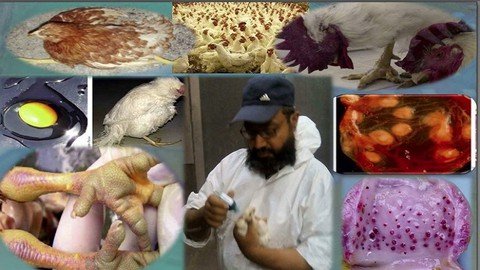
Note:
If you encounter an expired coupon or find that the course is no longer free when you click the link, it’s because the course instructors offer only a limited number of slots that quickly fill up. To secure your spot, enroll in the course promptly after it’s posted in the Telegram / Whatsapp channels. Keep in mind that coupons can expire at any time, so for immediate notifications, follow our Telegram / Whatsapp channels.
Welcome my colleagues my students My name is Mohamed AL ashram Veterinarian author instructor I share with you experience about important viral diseases impact poultry industry It is believed that poultry production started in Asia over 3000 years ago. he breeding of chickens in captivity dates back to at least 1400 BC in Egypt. But intensive poultry production only began in the 20th century. he past 100 years have seen an impressive growth, chiefly in the production of chickens and eggs, turkeys, ducks, and geese. the advent of vaccination for conditions such as Marek’s disease, in addition to remarkable improvements in nutrition, genetics management, that has allowed the poultry industry to quickly develop since the late 1960s. By the early 1980s, breeding increased greatly in complexity About 75% of poultry production in the world is done in intensive operations Chicken production Chicken production is, by far, the largest source of poultry meat in the world.
Turkey meat production is about 15 times smaller than chicken production The duck and goose industries represent about 7.5% of the world poultry meat production. EGG PRODUCTION The highly intensive practice of cage operations dates back to the 1950s. It was first saluted as the best approach to protect hens from unfavorable environmental conditions, Between 1999 and 2009, the world’s production of table eggs grew from around 49.8 million tons to more than 62 million tons, with a projected 16.5% increase by 2015 to 71 million tons THE FUTURE OF POULTRY PRODUCTION Many current health issues will still play a significant role in poultry production emphasis now and in coming years will be on improving Our ability to control diseases Globally, there has been a constant increase in poultry production Disease control high production product quality reasonable production costs have been the recent main goals of the poultry industry outbreaks of Newcastle disease, (ND), Infectious bursal disease (IBD) and Avian influenza (AI) Cause significant losses Viral diseases can reduce flock performance productivity profits without appearing as clinical disease Immune Suppression Effects of viruses include: stunting, gut disease, malabsorption, respiratory disease syndromes and immune suppression Effective vaccination programs require healthy immune systems Viral diseases are common, insidious, persistent and require a structured biosecurity program Viruses do their damage by causing primary tissue damage or by opening the gates for other infectious agents, such as bacteria and mycoplasmas, which might also be present, just waiting for a chance to act. anemia virus (CAV) infection. broiler flocks affected by clinical CAV infection from a vertically transmitting parent flock had a net income per 1000 birds 17 to 19% lower, average slaughter weight 3.3% higher mortality rate higher than that recorded in unaffected flocks.
Other work suggests that the depression of average weight can be as much as 12.8%. The major economic effects of viral diseases remain below the surface mortality and clinical disease how to investigate afield problem in this section we discuss methods for investigating a sick flock observation of every thing in a visit conducting necropsy The necropsy is essential to quickly observe the internal lesions, establish a differential diagnosis and decide on the course of action lab diagnosis Diseases that affect birds have a wide range of overlapping clinical signs and visible lesions. In most cases, samples need to be submitted to a diagnostic laboratory in order to provide a definitive diagnosis And identify the causative agent Laboratory techniques and instruments used by the avian diagnostician are numerous and can be quite sophisticated.
Accuracy of the results often depends on the quality of the samples submitted .An avian diagnostician interprets the clinical and laboratory results to determine the cause of disease. in detail describe avian influenza new castle disease virus gumboro Infectious bronchitis Duck virus enteritis duck virus hepatitis Avian Adeno Hemorrhagic enteritis of turkey I describe the clinical signs lesions diagnosis control methods
Instructor Bio: I fond of medicine science and technology reading and writing is my real fun I have medical back ground And a degree in vet medicine post graduated in microbiology Biochemistry Genetics
I find myself motivated to learn and teach every thing
Teaching is a responsibility and a mission
to transfer experience to our sons and daughters and our collages and students
EaseExam serves as the ultimate destination for 100% off and free Udemy coupons. Our dedicated team tirelessly search the internet seeking valid coupons to help you maximize your savings.